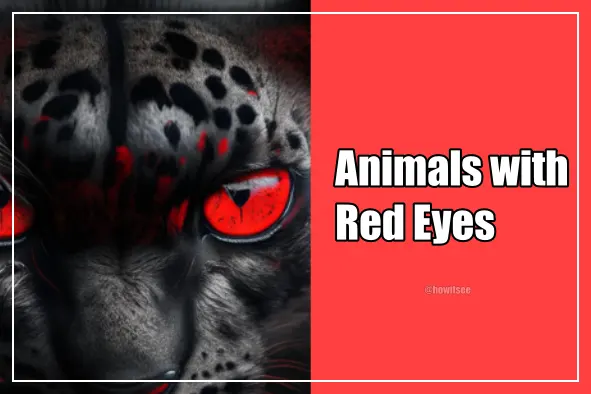The animal kingdom is a diverse world with various species that exhibit alluring characteristics that never fail to amaze us. The captivating prominence of red eyes is one such unique feature. We will set out on a voyage through the fascinating world of creatures with red eyes in this post.
We’ll explore the lifestyles and distinctive adaptations of 30 remarkable animals, each boasting eyes that radiate an otherworldly allure. Prepare to discover a kaleidoscope of nature’s wonders as we explore the diverse range of creatures that possess this striking trait. So, without further ado, let’s get started with our article, 30 Common Red Eye Animals.
Why Do Animals have Red Eyes?
Animals have red eyes that serve them several purposes, that depends of species to species and on their unique adaptations. For some, like in the case of Albino animals, the primary reason lies in the absence of the pigment melanin, while for others, the red eye color is due to the presence of colored pigments in the iris.
30 Red Eye Animals
1. Red-eyed Tree frog
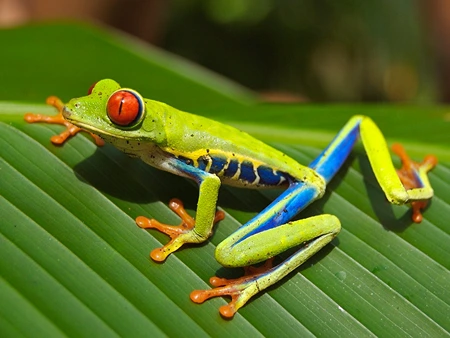
| Scientific name | Agalychnis callidryas |
| Size | 2-3 inches |
| Habitat | Inland forests and wetlands |
| Location | Central America |
| Diet | Insects like crickets, grasshoppers, flies etc. |
The first animal on this list of Red Eye Animals, we have the Red-eyed Tree Frog, a captivating amphibian popular for its striking red eyes.
The red coloration of the eyes can be attributed to the presence of pigments called lipochromes and several blood vessels in the iris, the colored portion of the eye.
The striking red color helps in defense, as it may startle the incoming predator, taking them off-guard.
2. Albino Rats
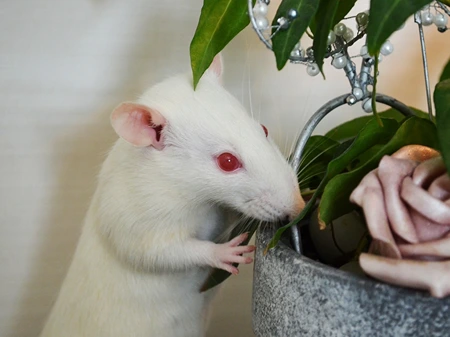
| Scientific name | Rattus norvegicus domestica |
| Size | up to 6 inches |
| Habitat | Mainly used in laboratories |
| Location | Worldwide |
| Diet | Fruits, cereals, meat etc. |
Albino Rats do not produce the pigment melanin, the one responsible for the coloration of the fur and the eyes. Due to the absence of melanin, their eyes become translucent.
As a consequence, light easily passes through the eyes and reflects off the blood vessels in the retina tissue at the back of the eye.
The retina is highly vascularized, and when the blood in these vessels reflects the light, it makes the eyes appear red or pink.
3. Ruby Eyed Green Pit Viper
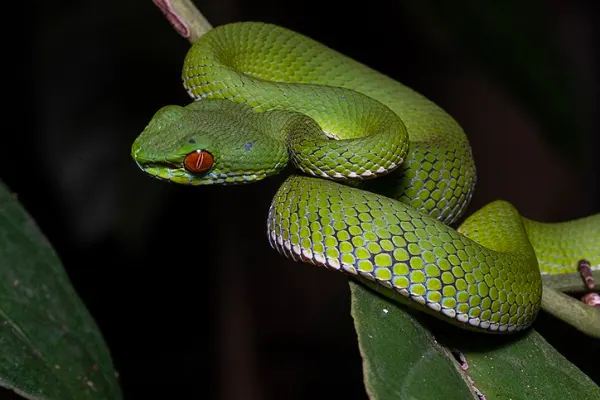
| Scientific name | Trimeresurus rubeus |
| Size | 3 feet |
| Habitat | Dense forest areas |
| Location | Southeast Asia |
| Diet | Small amphibians, birds, rodents etc. |
The Ruby Eyed Pit Viper is one of the latest inclusions in the pit viper family. Distinguishable by their bright red or crimson red eyes, Ruby Eyed Green Pit Vipers look quite intimidating.
The red color of their eyes is due to the presence of the pigment called lipochromes and also partly due to the vascularization of the retina.
4. European Adder
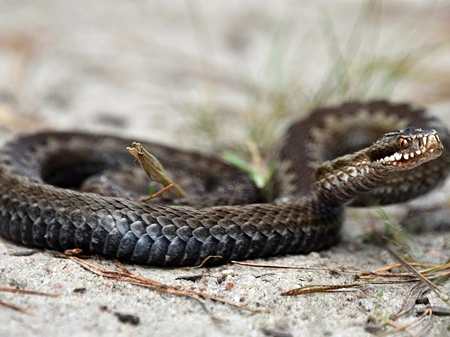
| Scientific name | Vipera berus |
| Size | up to 24 inches |
| Habitat | Meadows, bushy slopes, wood edges etc. |
| Location | Europe, East Asia |
| Diet | Mice, rats, weasels, moles, frogs, newts etc. |
The 4th animal in this list of Red Eye Animals is the European Adder. Native to Europe, this venomous snake has red eyes and vertically elliptical pupils.
This pupil shape allows for a wide field of binocular vision, which helps the snake accurately judge distance and depth perception.
For an ambush predator like the European Adder, it is an advantageous adaptation, as it relies on precise strikes to capture prey.
5. Satanic Leaf Tailed Gecko
| Scientific name | Uroplatus phantasticus |
| Size | 10-11 centimeters |
| Habitat | Mountainous rain forests |
| Location | Madagascar |
| Diet | Insects and other small invertebrates |
The Satanic Leaf-Tailed Gecko is a master of camouflage. With a body resembling a withering leaf, it is almost impossible to tell this gecko apart when it is camouflaging.
Satanic Leaf Tailed Geckos have a characteristic red-colored eye, and the color can vary from bright red to reddish-brown.
The striking eye color, combined with its leaf-like body shape and camouflage, serves as a formidable defense mechanism.
6. Red Eye Vireo
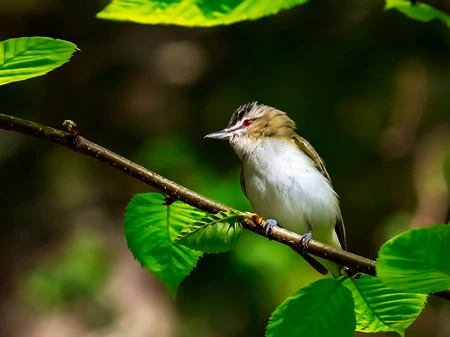
| Scientific name | Vireo olivaceus |
| Size | 4.5-5 inches |
| Habitat | Thin woody areas |
| Location | North America |
| Diet | Berries, insects, worms etc. |
Next up on this list of Red Eye Animals, we have a migratory songbird, the Red Eye Vireo. The Red-eyed Vireo has remarkable crimson or deep red coloring in its eyes. The abundance of pigments, notably carotenoids, in the iris, is what gives the eyes their vivid red color.
The bird’s food provides it with carotenoids, which are organic pigments found in plants. Many bird species, like the Red-eyed Vireo, have red coloring because of these pigments.
It’s unclear exactly how the crimson-eyed Vireo’s crimson eyes serve a purpose. It could function in communication and the identification of species, for instance.
7. Albino Giant Gourami

| Scientific name | Osphronemus gourami |
| Size | 18 inches |
| Habitat | Freshwater |
| Location | Southeast Asia |
| Diet | Algae, aquatic plants. brine shrimp, tubifex worms etc. |
The Albino Giant Gourami is quite a popular fish among aquarium hobbyists. Being an albino, it lacks the body pigment responsible for its color, resulting in a white or pale body. The pigment responsible for coloring, melanin, is absent from the eyes as well.
As a result, the Albino Giant Gourami’s eyes are generally pink or reddish in hue. The lack of pigmentation allows the underlying blood vessels and tissues of the eyes to be more visible, contributing to the distinct red color.
8. Black Crowned Night Heron
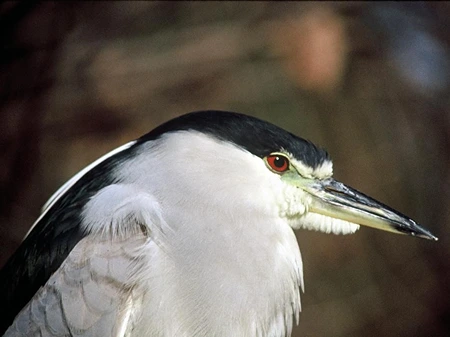
| Scientific name | Nycticorax nycticorax |
| Size | 22-8-26 inches |
| Habitat | Fresh and saltwater wetlands |
| Location | Worldwide |
| Diet | Fish, leeches, worms, mussels, small birds, carrion, snakes etc. |
The Night Heron is a popular predatory bird that is common in marshy or wetland areas. Part of their unique hunting abilities, what sets them apart is their striking eye coloration, which is red to reddish-orange.
The presence of pigments in the iris imparts a special eye color. Night Heron’s eyes are specially adapted for accurate depth perception for fishes underwater.
9. Angel Fish
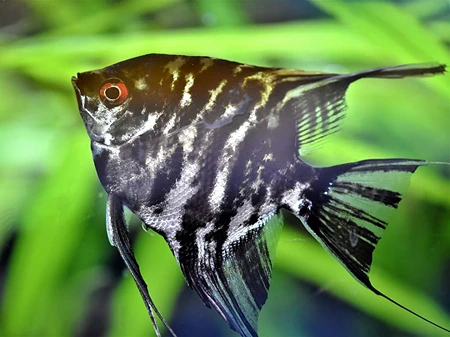
| Scientific name | Pterophyllum altum |
| Size | may even reach sizes up to 15 inches (dorsal fin tip to anal fin tip) |
| Habitat | Freshwaters and river basins |
| Location | South America |
| Diet | Worms and small crustaceans |
The next animal on this list of Red Eye animals is the Angel Fish. One of the most common fishes in the aquarium hobby, Angel Fishes may exhibit red eyes either in their albino form or sometimes even in the normal fishes.
As told previously, the albino fishes develop red eyed due to the absence of melanin pigment, while those in normal fishes might be a result of some pigmentation.
10. Bronzed Cowbird
| Scientific name | Molothrus aeneus |
| Size | 7.3-7.9 inches |
| Habitat | Farmlands, brushes. feedlots |
| Location | Southern regions of North America |
| Diet | Seeds, grasses, insects and arthropods |
When it comes to their eyes, the Bronzed Cowbirds possess distinct characteristics that contribute to their visual perception and behavior. The eyes of the Bronzed Cowbird are usually dark brown.
The color changes to bright red for males during the breeding season. The color change may be used for signaling mates, for selecting the potential mate, or for competitive signaling among rivals.
11. Asian Koel

| Scientific name | Eudynamys scolopaceus |
| Size | 15-18 inches |
| Habitat | Light woodland |
| Location | Tropical Southern Asia |
| Diet | Insects, caterpillars, fruits etc. |
A species of the cuckoo bird, the Asian Koel is quite a popular bird in South and Southeast Asia. Though both the males and the females share the same red eyes, it is the males that look more captivating.
With a glossy bluish-black plumage, the red eyes look quite striking, resembling embedded red crystals. Though the exact cause of their red eyes is currently unknown, it may be primarily due to the presence of red coloring pigments in their iris.
12. Wood Duck
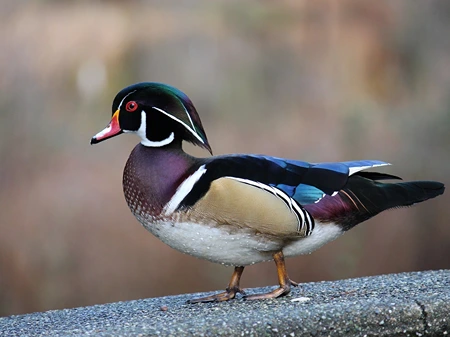
| Scientific name | Aix sponsa |
| Size | 19-21 inches |
| Habitat | Swamps, shallow lakes, marshlands |
| Location | USA |
| Diet | Berries, acorns, insects |
While the Wood Duck has many alluring characteristics, its stunning red eyes stand out in particular. These blazing orbs give the already beautiful bird a dash of vibrancy. Wood Duck’s ruby eyes have both functional and aesthetic uses.
Since the red color is linked to oil droplets called carotenoids, which improve their eyesight, the vivid red coloring serves to improve their visual acuity.
This is especially true in low-light situations. The Wood Duck’s ruby eyes add to its appeal and refinement on a visual level.
The red eyes can become more intense during courting displays, enhancing the appeal and interest of their interactions.
13. Red Eye Tetras

| Scientific name | Moenkhausia sanctaefilomenae |
| Size | 2.8 inches |
| Habitat | Freshwater |
| Location | South America, now common in aquariums |
| Diet | Worms, insects, crustaceans, plant matter |
The next animal in this list of Red Eye Animals is the Red Eye Tetra, one of the best beginner fishes in the aquarium hobby.
As the name suggests, these fishes can be easily distinguished by the red rim in the periphery of their eyes, which look quite captivating against silvery grey scales.
It is thought that the Red Eye Tetras’ red or golden eyes are a consequence of specialized pigments in their iris. These pigments, like carotenoids, come from the food they eat.
Although the red eye coloring of Red Eye Tetras is assumed to serve a variety of purposes, its specific function is not fully known. The red eyes may contribute to species recognition, mate selection, or communication within their social groups.
14. Common Loon
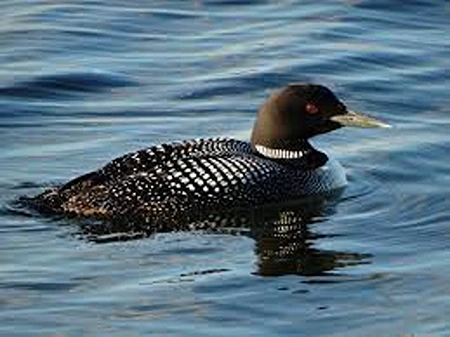
| Scientific name | Gavia immer |
| Size | 70-90 centimeters |
| Habitat | Waterways |
| Location | North America |
| Diet | Fish, crustaceans, invertebrates, fish |
The eye color of a Common Loon has been quite a hit subject of debate among bird enthusiasts. While some are for the notion that their red eyes aid in underwater vision others stand for the notion that their red eyes aid in filtering the excessive brightness of the sun-dappled water.
However, the famous bird researcher, Laura Erickson discarded both the facts saying that if such was the case, then young birds would have been born with red eyes too which is not the case. The red color is the color on the iris, and it mainly helps in inter-species attention.
15. American Coot

| Scientific name | Fulica americana |
| Size | 13-17 inches |
| Habitat | Wetlands and open water bodies, ponds, open marshes |
| Location | North America |
| Diet | Fish, crustaceans, arthropods |
American Coots have fascinating eye features that help them see and adapt to their environment. American Coots often have vivid red eyes as their eye color. Their eyes are distinguishable due to the vibrant red color that contrasts with their dark grey or black plumage.
The pigments and blood arteries in their irises are what give them their crimson eyes. American Coots have both functional and aesthetically pleasing red eyes.
They help the birds see better underwater, which improves their ability to find and catch aquatic prey. The red coloring may also help them see better under different lighting conditions and offer some glare prevention.
16. Red Eyed Leaf hopper
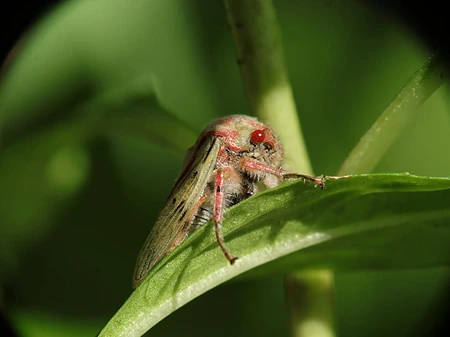
| Scientific name | Circulifer tenellus |
| Size | up to 10 millimeters |
| Habitat | Grassy areas |
| Location | Worldwide |
| Diet | grasses |
The next organism in this list of Red Eye Animals is the Red Eye Leafhopper, quite distinguishable for its bright red eyes, against a green body color.
The red eye is a result of certain pigments, which absorb the visible radiations, but reflect off only the red color light.
This may help particularly in mate identification through visual cues. Another function may be to warn predators, as red generally represents toxicity, thereby referring to the fact that these insects may be toxic or unpalatable.
17. White Winged Chough
| Scientific name | Corcorax melanorhamphos |
| Size | 18 inches |
| Habitat | Open grasslands, meadows |
| Location | Southern and Eastern Australia |
| Diet | Termites and beetle |
In the 17th position on this list of Red Eye Animals, we have the White Winged Chough, known for its distinctive eye color. The White-winged Chough has comparatively big eyes that are encircled by bare, pale skin.
This species’ eyes are often a stunning brilliant red color, which contrasts with its glossy black feathers. They are instantly recognizable and enticing to the eye due to the striking contrast provided by the intense red color of their eyes.
Specialized pigments in the irises of White-winged Choughs cause their eyes to be red. The red color that people see is reflected by these pigments after they absorb specific light wavelengths.
18. Horned Grebe
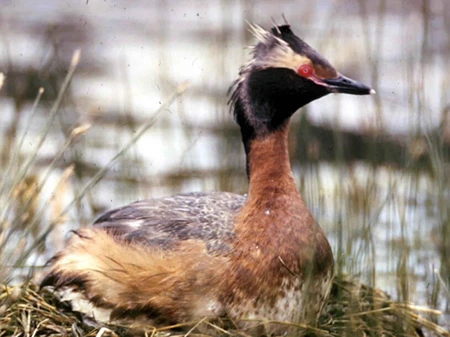
| Scientific name | Podiceps auritus |
| Size | 31-38 centimeters |
| Habitat | Coasts and open waters |
| Location | Eurasia and North America |
| Diet | Fish, arthropods, molluscs |
The Horned Grebe’s eyes are often a darker shade of red. The pigments and blood vessels in its eyes are what give it this color.
The pigments in the eyes aid in the absorption of specific light wavelengths and the reduction of glare, improving the bird’s ability to see underwater.
The Horned Grebe also uses its eyes to communicate visually and perform courting displays. The color of the eyes may become more intense during the mating season, making them look brighter and more noticeable to potential mates.
19. Asian Glossy Starling
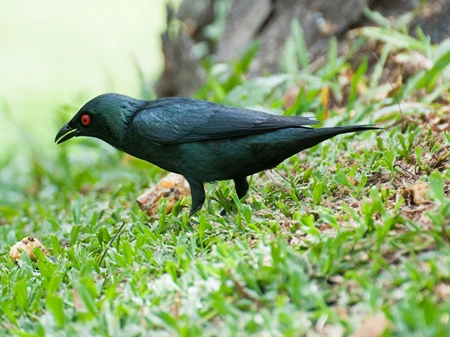
| Scientific name | Aplonis panayensis |
| Size | 20 centimeters |
| Habitat | Tropical and subtropical moist lowland forests |
| Location | Bangladesh, India, Indonesia, Malaysia |
| Diet | Omnivorous |
The Rosy Billed Pochard’s eyes are quite similar to any other waterbird on this. Apart from having a characteristic red colored bill, they also have red color irises around their pupils.
It serves the same purpose, as any other waterbird, to enhance vision underwater by reducing the glare, and during courtship rituals. The reason for the red color being special coloring pigments.
20. Albino Bat
| Order | Chiroptera |
| Size | Varying sizes, depending on the species |
| Habitat | Forests, dark attics, caves |
| Location | Worldwide |
| Diet | Insects, nectar and sometimes even blood (vampire bats) |
The term albino refers to those animals whose body lacks the body coloring pigment, melanin. Since the body does not produce melanin, the fur is white and the skin is pinkish due to the underlying blood vessels.
The eyes appear red due to the light that enters the eye and gets reflected by the blood in the retina since the absence of melanin makes the eyes translucent.
21. Rosy Billed Pochard
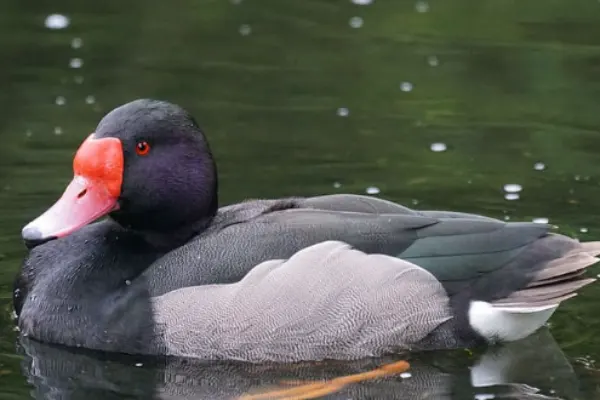
| Scientific name | Netta peposaca |
| Size | 22 inches |
| Habitat | Wetlands with Tall Grasses |
| Location | South America |
| Diet | Grasses, roots, and some animal products |
The Rosy Billed Pochard’s eyes are quite similar to any other waterbird on this. Apart from having a characteristic red colored bill, they also have red color irises around their pupils.
It serves the same purpose, as any other waterbird, to enhance vision underwater by reducing the glare, and during courtship rituals. The reason for the red color being special coloring pigments.
22. Albino Cornsnake
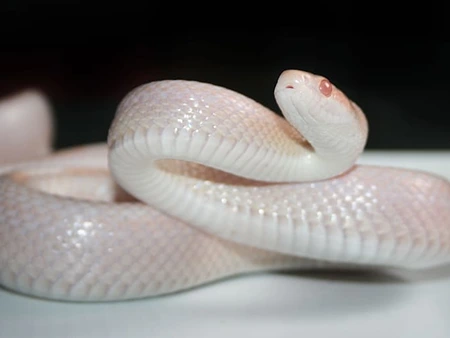
| Scientific name | Pantherophis guttatus |
| Size | 2-6 feet |
| Habitat | Grasslands, open rocky areas, pine forests |
| Location | Southeastern USA |
| Diet | Rats, mice |
The next animal on this list of Red Eye Animals is one of the most expensive and sought-after snakes in the pet hobby, the Albino Cornsnake.
Much like other albino animals on this list, they too lack the pigment melanin, causing their eyes to give a pinkish-red hue.
23. Soapberry Bugs
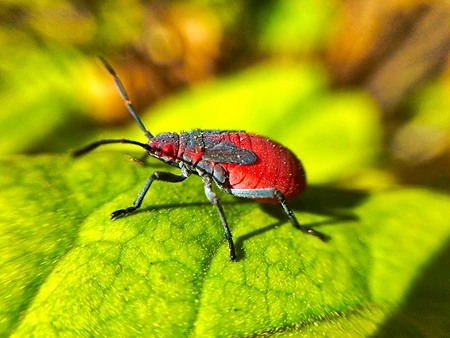
| Scientific name | Jadera haematoloma |
| Size | 9.5-13.5 millimeters |
| Habitat | Trees and forest floor |
| Location | Florida, Kansas, Colorado etc. |
| Diet | Tree saps, dead insects |
While their eyes may not be as visually striking as some other animals on this list, they do possess certain interesting eye characteristics.
They are compound eyes, which means they consist of multiple individual visual units called ommatidia which allow the bugs to perceive their surroundings and detect light and movement.
The color of the eyes in soapberry bugs varies among species but is typically reddish brown.
24. Albino California Kingsnake
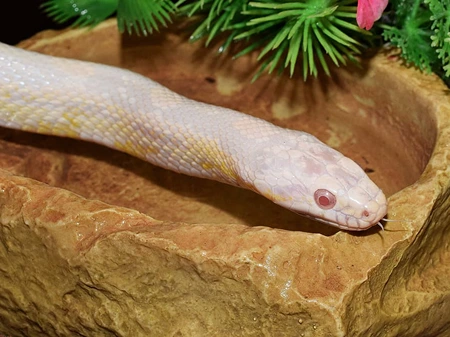
| Scientific name | Lampropeltis californiae |
| Size | 2.5-3.5 feet |
| Habitat | Woodlands, grasslands, marshlands |
| Location | West Coast of North America |
| Diet | Amphibians, rodents, birds |
The Albino California Kingsnake typically has pink or reddish eyes. The absence of pigments like melanin, which are often responsible for the dark eyes seen in non-albino snakes, contributes to this eye color.
Without these pigments, the blood vessels and tissues in the eye are more apparent giving them a pink or reddish tinge that adds to their distinctive and alluring look and makes them a sought-after morph among snake enthusiasts and breeders.
It’s important to keep in mind that compared to non-albino individuals, albino California Kingsnake eyes might be more sensitive to strong light. Therefore, it is crucial for its wellbeing, to provide suitable lighting and avoid overexposing it to brightness.
25. Red-eyed Eastern Towhee
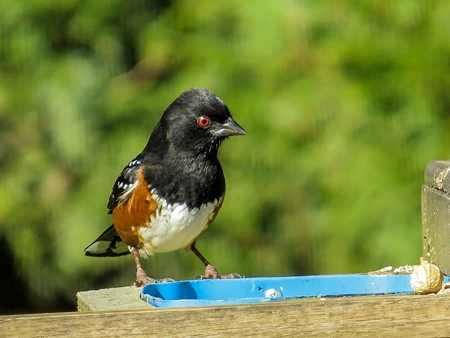
| Scientific name | Pipilo erythrophthalmus |
| Size | 6.8-9 inches |
| Habitat | areas of light vegetation |
| Location | Eastern United States |
| Diet | Seeds, fruits,lizards, amphibians etc. |
The Red-eyed Towhee’s eyes are incredibly alluring, with a vivid red color that stands out against its black plumage. The pigments in the bird’s irises are what result in their brilliant eye color.
The Red-eyed Eastern Towhee’s striking crimson eyes are what first catch people’s attention. They strikingly contrast with the bird’s black plumage, making it stand out and aiding in inter-species identification as well as partner choice during courting rituals.
26. Red Eyed Fruitfly
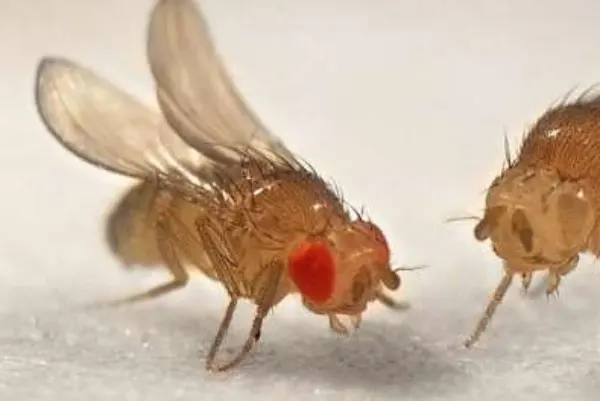
| Scientific name | Drosophila melanogaster |
| Size | 0.1 inches long |
| Habitat | Near fruity matter |
| Location | Worldwide |
| Diet | Fruits |
The Red-eyed Drosophila, is a species of fruit fly that is frequently used as a model organism in scientific studies. The compound eyes of the Red-eyed Drosophila are made up of multiple small, distinct visual units called ommatidia, each of which contains an aggregate of light-sensitive photoreceptor cells.
The term “Red-eyed Drosophila” refers to the bug’s distinctively red eyes. The buildup of a red pigment called drosopterin is what causes red eye pigmentation.
A complicated biochemical pathway comprising several enzymes and genes results in the production of this pigment. Different eye pigmentation phenotypes can emerge from changes in eye color caused by mutations in these genes.
27. Red eyed Damselfly

| Scientific name | Erythromma najas |
| Size | 1.4 inches |
| Habitat | Watery areas |
| Location | Worldwide |
| Diet | Flies, mosquitoes etc. |
Next up, on this list of Red Eye Animals, we have the Red-eyed Damselflies. Keeping in view that their body color and pigmentation change, depending on their s*x and age, we will be considering only mature males.
The eye color is caused by redox reactions in the ommochrome pigments, namely Xanthommatin, the different ratio of which results in the different shades of red.
28. Red Eye Bass
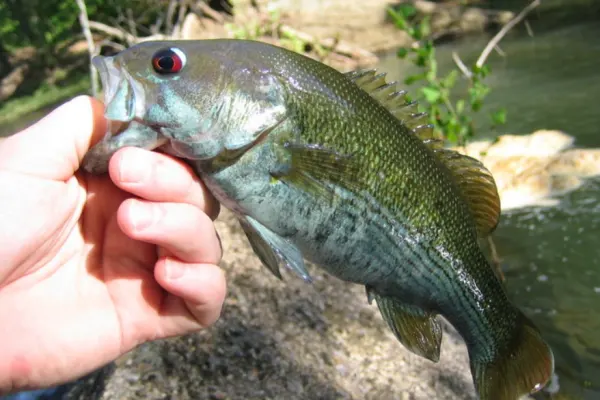
| Scientific name | Micropterus coosae |
| Size | 19 inches |
| Habitat | Coosa River System |
| Location | Alabama |
| Diet | Smaller fishes, shrimps etc. |
Pigments found in the tissues of the eyes are what give Red-Eyed Basses their red eyes.
Although the precise pigments causing the red color in Redeye Bass have not been well examined, it is thought that a variety of pigments, including carotenoids and pteridines, are involved.
These pigments are a part of what gives their eyes their striking red color. The genetic makeup of the fish has a significant impact on how these pigments are produced, thereby regulating the eye color.
29. Red Snapper
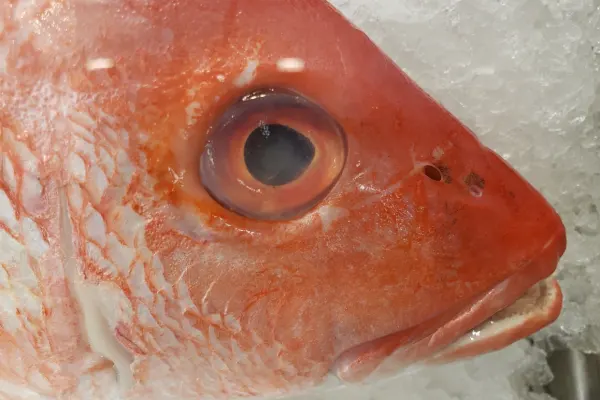
| Scientific name | Lutjanus campechanus |
| Size | 24 inches |
| Habitat | Marine waters |
| Location | Gulf of Mexico, Caribbean Sea |
| Diet | Fish, shrimp, crabs, worms etc. |
The Red Snapper is a popular fish known for its taste and coloration. Apart from its red-colored body, its eyes are also red, which sets this fish apart.
Like other fishes in this list, the eyes of Red Snappers also contain red coloring pigments, which reflect the red light of the visible spectrum, thus giving its eyes a reddish hue.
Overfishing has severely affected the population of this fish in marine waters, and therefore, its harvesting is now regulated.
30. Discus Fish

| Scientific name | Symphysodon sp. |
| Size | 4.8-6.0 inches |
| Habitat | Amazon River |
| Location | South America |
| Diet | Worms, crustaceans, plants |
The last animal in this list of Red Eye Animals is the Discuss Fish. Discus fish are calm and attractive to look at in an aquarium. Most aquarium lovers want them for their variety of colors and docile personalities.
Many of the Discuss breeds like the Blue Discuss, Heckel Cross Discuss, Albino Golden Discuss, Red Sun Discuss, etc., have red eyes. The red color is caused by a red eye gene, which results in the synthesis of the pigment responsible for the red color.
However, red eyes are always not a common feature in fishes, and many times it may be due to some infection or disease. In those cases, immediate medical aid should be provided to your fishes.
Now, its time to conclude to conclude this article on 30 Red Eye Animals. Do let us know your views in our social media handles. We will be back soon with another article. Until then, you may check out our other write-ups on several other niches like reptiles, mammals, birds, insects etc.
References:
- Laura Erickson’s For the Birds- Loon Eye Color
- Color vision and color formation in dragonflies- Ryo Futahashi
- 31 Types of Discuss- Petkeen
Also Read:

A zoology student turned writer. Nature has always been a magnet to me, and to unearth some of its secrets through my articles is my prime intention. If not engaging myself with nature and anime content, you can always find me going through some Bengali classics or filling the air with some soulful Tabla beats. An artist, trying to throw some colors to my blank canvas of life.
